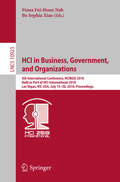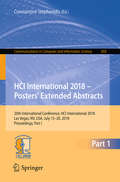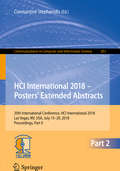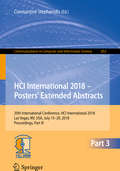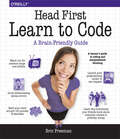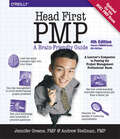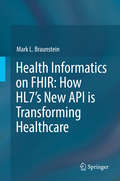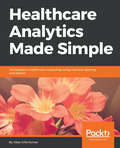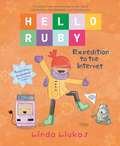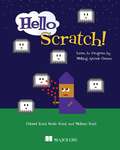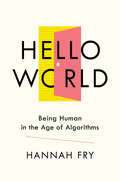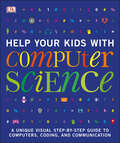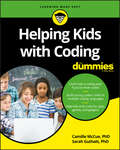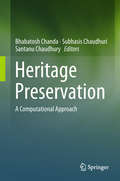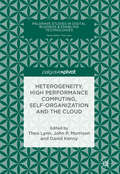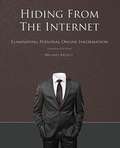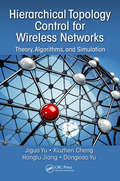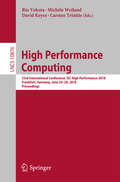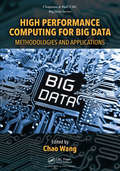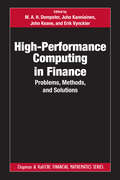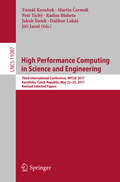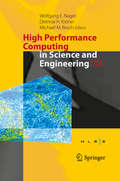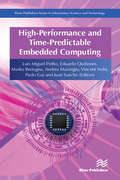- Table View
- List View
The Haskell School of Music: From Signals to Symphonies
by Paul Hudak Donya QuickThis book explores the fundamentals of computer music and functional programming through the Haskell programming language. Functional programming is typically considered difficult to learn. This introduction in the context of creating music will allow students and professionals with a musical inclination to leverage their experience to help understand concepts that might be intimidating in more traditional computer science settings. Conversely, the book opens the door for programmers to interact with music by using a medium that is familiar to them. Readers will learn how to use the Euterpea library for Haskell (http://www.euterpea.com) to represent and create their own music with code, without the need for other music software. The book explores common paradigms used in algorithmic music composition, such as stochastic generation, musical grammars, self-similarity, and real-time interactive systems. Other topics covered include the basics of signal-based systems in Haskell, sound synthesis, and virtual instrument design.
¡Hazla en grande!
by Gary VaynerchukUna guía de vanguardia para construir tu propio camino hacia el éxito profesional y financiero. Aprende a construir tu negocio y a influir en los demás como lo hacen los grandes empresarios. Gary Vaynerchuk detalla por qué es fundamental crear una marca personal vibrante para el éxito empresarial, ofreciendo una perspectiva única sobre lo que ha cambiado con las redes sociales y qué principios son eternos. A través de historias de éxito de otros empresarios y su propia historia, explica por qué el éxito tiene mucho que ver con la comprensión de las plataformas de redes sociales y la voluntad de hacer todo lo posible para que estas herramientas funcionen a su máximo potencial. En este libro práctico, Gary analiza cada una de las principales plataformas de redes sociales para que cualquiera sepa exactamente cómo amplificar su marca personal en cada una. Ofrece consejos teóricos y tácticos sobre cómo convertirse en el más relevante en plataformas, desde las más conocidas como YouTube e Instagram, hasta las emergentes como Musical.ly. Para aquellos con más experiencia, ¡Hazla en grande! ilumina algunos matices poco conocidos y proporciona consejos innovadores y ajustes inteligentes probados para mejorar las estrategias probadas más comunes.
HCI in Business, Government, and Organizations: 5th International Conference, HCIBGO 2018, Held as Part of HCI International 2018, Las Vegas, NV, USA, July 15-20, 2018, Proceedings (Lecture Notes in Computer Science #10923)
by Fiona Fui-Hoon Nah Bo Sophia XiaoThis book constitutes the refereed proceedings of the 5th International Conference on HCI in Business, Government and Organizations, HCIBGO 2018, held as part of the 20th International Conference on Human-Computer Interaction, HCII 2018, in Las Vegas, NV, USA. The 1171 full papers and 160 posters presented at the 14 co-located HCII 2018 conferences were carefully reviewed and selected from a total of 4346 submissions. The papers address the latest research and development efforts and highlight the human aspects of design and use of computing systems. The papers thoroughly cover the entire field of human-computer interaction, addressing major advances in knowledge and effective use of computers in a variety of application areas. The papers included in this volume cover the following topics: information systems in business; electronic commerce and consumer behavior; social media and social communities in business; social innovation; and business analytics and visualization.
HCI International 2018 – Posters' Extended Abstracts: 20th International Conference, HCI International 2018, Las Vegas, NV, USA, July 15-20, 2018, Proceedings, Part I (Communications in Computer and Information Science #850)
by Constantine StephanidisThe three-volume set CCIS 850, CCIS 851, and CCIS 852 contains the extended abstracts of the posters presented during the 20th International Conference on Human-Computer Interaction, HCI 2018, which took place in Las Vegas, Nevada, in July 2018.The total of 1171 papers and 160 posters included in the 30 HCII 2018 proceedings volumes was carefully reviewed and selected from 4346 submissions. The 207 papers presented in these three volumes are organized in topical sections as follows: Part I: interaction and information; images and visualizations; design, usability and user experience; psychological, cognitive and neurocognitive issues in HCI; social media and analytics. Part II: design for all, assistive and rehabilitation technologies; aging and HCI; virtual and augmented reality; emotions, anxiety, stress and well-being. Part III: learning and interaction; interacting with cultural heritage; HCI in commerce and business; interacting and driving; smart cities and smart environments.The chapter 'Information at Hand – Using Wearable Devices to Display Task Information in the Context of Industry 4.0' is open access under a CC BY 4.0 license via link.springer.com.
HCI International 2018 – Posters' Extended Abstracts: 20th International Conference, HCI International 2018, Las Vegas, NV, USA, July 15-20, 2018, Proceedings, Part II (Communications in Computer and Information Science #851)
by Constantine StephanidisThe three-volume set CCIS 850, CCIS 851, and CCIS 852 contains the extended abstracts of the posters presented during the 20th International Conference on Human-Computer Interaction, HCI 2018, which took place in Las Vegas, Nevada, in July 2018.The total of 1171 papers and 160 posters included in the 30 HCII 2018 proceedings volumes was carefully reviewed and selected from 4346 submissions. The 207 papers presented in these three volumes are organized in topical sections as follows: Part I: interaction and information; images and visualizations; design, usability and user experience; psychological, cognitive and neurocognitive issues in HCI; social media and analytics. Part II: design for all, assistive and rehabilitation technologies; aging and HCI; virtual and augmented reality; emotions, anxiety, stress and well-being. Part III: learning and interaction; interacting with cultural heritage; HCI in commerce and business; interacting and driving; smart cities and smart environments.
HCI International 2018 – Posters' Extended Abstracts: 20th International Conference, HCI International 2018, Las Vegas, NV, USA, July 15-20, 2018, Proceedings, Part III (Communications in Computer and Information Science #852)
by Constantine StephanidisThe three-volume set CCIS 850, CCIS 851, and CCIS 852 contains the extended abstracts of the posters presented during the 20th International Conference on Human-Computer Interaction, HCI 2018, which took place in Las Vegas, Nevada, in July 2018.The total of 1171 papers and 160 posters included in the 30 HCII 2018 proceedings volumes was carefully reviewed and selected from 4346 submissions. The 207 papers presented in these three volumes are organized in topical sections as follows: Part I: interaction and information; images and visualizations; design, usability and user experience; psychological, cognitive and neurocognitive issues in HCI; social media and analytics. Part II: design for all, assistive and rehabilitation technologies; aging and HCI; virtual and augmented reality; emotions, anxiety, stress and well-being. Part III: learning and interaction; interacting with cultural heritage; HCI in commerce and business; interacting and driving; smart cities and smart environments.
Head First Learn to Code: A Learner's Guide to Coding and Computational Thinking
by Eric FreemanWhat will you learn from this book?It’s no secret the world around you is becoming more connected, more configurable, more programmable, more computational. You can remain a passive participant, or you can learn to code. With Head First Learn to Code you’ll learn how to think computationally and how to write code to make your computer, mobile device, or anything with a CPU do things for you. Using the Python programming language, you’ll learn step by step the core concepts of programming as well as many fundamental topics from computer science, such as data structures, storage, abstraction, recursion, and modularity.Why does this book look so different?Based on the latest research in cognitive science and learning theory, Head First Learn to Code uses a visually rich format to engage your mind, rather than a text-heavy approach that puts you to sleep. Why waste your time struggling with new concepts? This multi-sensory learning experience is designed for the way your brain really works.
Head First PMP: A Learner's Companion to Passing the Project Management Professional Exam (Head First Ser.)
by Jennifer Greene Andrew StellmanNow updated for the 2021 PMP Exam What will you learn from this book?Head First PMP teaches you the latest principles and certification objectives in The PMBOK® Guide in a unique and inspiring way. This updated fourth edition takes you beyond specific questions and answers with a unique visual format that helps you grasp the big picture of project management. By putting PMP concepts into context, you'll be able to understand, remember, and apply them--not just on the exam, but on the job. No wonder so many people have used Head First PMP as their sole source for passing the PMP exam.This book will help you:Learn PMP's underlying concepts to help you understand the PMBOK principles and pass the certification exam with flying colorsGet 100% coverage of the latest principles and certification objectives in The PMBOK® Guide, Sixth EditionMake use of a thorough and effective preparation guide with hundreds of practice questions and exam strategiesExplore the material through puzzles, games, problems, and exercises that make learning easy and entertainingWhy does this book look so different?Based on the latest research in cognitive science and learning theory, Head First PMP uses a visually rich format to engage your mind, rather than a text-heavy approach that puts you to sleep. Why waste your time struggling with new concepts? This multi-sensory learning experience is designed for the way your brain really works.
Health Informatics on FHIR: How HL7's New API is Transforming Healthcare
by Mark L. BraunsteinThis textbook begins with an introduction to the US healthcare delivery system, its many systemic challenges and the prior efforts to develop and deploy informatics tools to help overcome those problems. It goes on to discuss health informatics from an historical perspective, its current state and its likely future state now that electronic health record systems are widely deployed, the HL7 Fast Healthcare Interoperability standard is being rapidly accepted as the means to access the data stored in those systems and analytics is increasing being used to gain new knowledge from that aggregated clinical data. It then turns to some of the important and evolving areas of informatics including population and public health, mHealth and big data and analytics. Use cases and case studies are used in all of these discussions to help readers connect the technologies to real world challenges. Effective use of informatics systems and tools by providers and their patients is key to improving the quality, safety and cost of healthcare. With health records now digital, no effective means has existed for sharing them with patients, among the multiple providers who may care for them and for important secondary uses such as public/population health and research. This problem is a topic of congressional discussion and is addressed by the 21st Century Cures Act of 2016 that mandates that electronic health record (EHR) systems offer a patient-facing API. HL7’s Fast Healthcare Interoperability Resources (FHIR) is that API and this is the first comprehensive treatment of the technology and the many ways it is already being used. FHIR is based on web technologies and is thus a far more facile, easy to implement approach that is rapidly gaining acceptance. It is also the basis for a ‘universal health app platform’ that literally has the potential to foster innovation around the data in patient records similar to the app ecosystems smartphones created around the data they store. FHIR app stores have already been opened by Epic and Cerner, the two largest enterprise EHR vendors. Provider facing apps are already being explored to improve EHR usability and support personalized medicine. Medicare and the Veteran’s Administration have announced FHIR app platforms for their patients. Apple’s new IOS 11.3 features the ability for consumers to aggregate their health records on their iPhone using FHIR. Health insurance companies are exploring applications of FHIR to improve service and communication with their providers and patients. SureScripts, the national e-Prescribing network, is using FHIR to help doctors know if their patients are complying with prescriptions. This textbook is for introductory health informatics courses for computer science and health sciences students (e.g. doctors, nurses, PhDs), the current health informatics community, IT professionals interested in learning about the field and practicing healthcare providers. Though this textbook covers an important new technology, it is accessible to non-technical readers including healthcare providers, their patients or anyone interested in the use of healthcare data for improved care, public/population health or research.
Healthcare Analytics Made Simple: Techniques in healthcare computing using machine learning and Python
by Vikas Vik KumarAdd a touch of data analytics to your healthcare systems and get insightful outcomesKey FeaturesPerform healthcare analytics with Python and SQLBuild predictive models on real healthcare data with pandas and scikit-learnUse analytics to improve healthcare performanceBook DescriptionIn recent years, machine learning technologies and analytics have been widely utilized across the healthcare sector. Healthcare Analytics Made Simple bridges the gap between practising doctors and data scientists. It equips the data scientists’ work with healthcare data and allows them to gain better insight from this data in order to improve healthcare outcomes.This book is a complete overview of machine learning for healthcare analytics, briefly describing the current healthcare landscape, machine learning algorithms, and Python and SQL programming languages. The step-by-step instructions teach you how to obtain real healthcare data and perform descriptive, predictive, and prescriptive analytics using popular Python packages such as pandas and scikit-learn. The latest research results in disease detection and healthcare image analysis are reviewed.By the end of this book, you will understand how to use Python for healthcare data analysis, how to import, collect, clean, and refine data from electronic health record (EHR) surveys, and how to make predictive models with this data through real-world algorithms and code examples.What you will learnGain valuable insight into healthcare incentives, finances, and legislation Discover the connection between machine learning and healthcare processesUse SQL and Python to analyze dataMeasure healthcare quality and provider performanceIdentify features and attributes to build successful healthcare models Build predictive models using real-world healthcare dataBecome an expert in predictive modeling with structured clinical dataSee what lies ahead for healthcare analyticsWho this book is forHealthcare Analytics Made Simple is for you if you are a developer who has a working knowledge of Python or a related programming language, although you are new to healthcare or predictive modeling with healthcare data. Clinicians interested in analytics and healthcare computing will also benefit from this book. This book can also serve as a textbook for students enrolled in an introductory course on machine learning for healthcare.
Hello Ruby: Expedition to the Internet (Hello Ruby #3)
by Linda LiukasWelcome back to the world's most whimsical way to learn about technology and coding in Hello Ruby: Expedition to the Internet, as Linda Liukas, a programming superstar, teaches kids all about the internet through storytelling and imaginative activities.What exactly is the Internet? Is it a cloud? A network of wires? How does the information travel online? Learn all this and more with Ruby!In Ruby’s world anything is possible if you put your mind to it—even building the Internet out of snow! But before you can build something, you need to understand what it is and how it works. Join Ruby and her friends in their quest to build the most amazing Snow Internet ever, while learning real life facts along the way. Then, future kid coders can put their knowledge and imaginations to the test with the fun and creative exercises included in the activity book section.
Hello Scratch!: Learn to program by making arcade games
by Melissa FordSummaryHello, Scratch! is a how-to book that helps parents and kids work together to learn programming skills by creating new versions of old retro-style arcade games with Scratch.Purchase of the print book includes a free eBook in PDF, Kindle, and ePub formats from Manning Publications.About the TechnologyCan 8-year-olds write computer programs? You bet they can! In Scratch, young coders use colorful blocks and a rich graphical environment to create programs. They can easily explore ideas like input and output, looping, branching, and conditionals. Scratch is a kid-friendly language created by MIT that is a safe and fun way to begin thinking like a programmer, without the complexity of a traditional programming language.About the BookHello Scratch! guides young readers through five exciting games to help them take their first steps in programming. They'll experiment with key ideas about how a computer program works and enjoy the satisfaction of immediate success. These carefully designed projects give readers plenty of room to explore by imagining, tinkering, and personalizing as they learn.What's InsideLearn by experimentationLearn to think like a programmerBuild five exciting, retro-style gamesVisualize the organization of a programAbout the ReadersWritten for kids 8-14. Perfect for independent learning or working with a parent or teacher.About the AuthorsKids know how kids learn. Sadie and Gabriel Ford, 12-year-old twins and a formidable art and coding team, wrote this book with editing help from their mother, author Melissa Ford!Table of ContentsPART 1 - SETTING UP THE ARCADEGetting to know your way around ScratchBecoming familiar with the Art EditorMeeting Scratch's key blocks through important coding conceptsPART 2 - TURNING ON THE MACHINESDesigning a two-player ball-and-paddle gameUsing conditionals to build a two-player ball-and-paddle gamePART 3 - CODING AND PLAYING GAMESDesigning a fixed shooterUsing conditionals to build your fixed shooterDesigning a one-player ball-and-paddle gameUsing variables to build your one-player ball-and-paddle gameDesigning a simple platformerUsing X and Y coordinates to make a simple platformerMaking a single-screen platformerUsing arrays and simulating gravity in a single-screen platformerBecoming a game maker
Hello World: Being Human in the Age of Algorithms
by Hannah FryShortlisted for the 2018 Royal Society Investment Science Book Prize A look inside the algorithms that are shaping our lives and the dilemmas they bring with them. If you were accused of a crime, who would you rather decide your sentence—a mathematically consistent algorithm incapable of empathy or a compassionate human judge prone to bias and error? What if you want to buy a driverless car and must choose between one programmed to save as many lives as possible and another that prioritizes the lives of its own passengers? And would you agree to share your family’s full medical history if you were told that it would help researchers find a cure for cancer? These are just some of the dilemmas that we are beginning to face as we approach the age of the algorithm, when it feels as if the machines reign supreme. Already, these lines of code are telling us what to watch, where to go, whom to date, and even whom to send to jail. But as we rely on algorithms to automate big, important decisions—in crime, justice, healthcare, transportation, and money—they raise questions about what we want our world to look like. What matters most: Helping doctors with diagnosis or preserving privacy? Protecting victims of crime or preventing innocent people being falsely accused? Hello World takes us on a tour through the good, the bad, and the downright ugly of the algorithms that surround us on a daily basis. Mathematician Hannah Fry reveals their inner workings, showing us how algorithms are written and implemented, and demonstrates the ways in which human bias can literally be written into the code. By weaving in relatable, real world stories with accessible explanations of the underlying mathematics that power algorithms, Hello World helps us to determine their power, expose their limitations, and examine whether they really are improvement on the human systems they replace.
Help Your Kids with Computer Science (DK Help Your Kids)
by DKFrom coding languages and hardware to cyberbullying and gaming, this comprehensive homework helper for kids and parents covers the essentials of computer science. This unique visual study guide examines the technical aspects of computers, such as how they function, the latest digital devices and software, and how the Internet works. It also builds the confidence of parents and kids when facing challenges such as staying safe online, digital etiquette, and how to navigate the potential pitfalls of social media. Jargon-free language helps to explain difficult and potentially dread-inducing homework such as hacking, "big data" and malware, while colorful graphics help makes learning about the world of computer science exciting. Whether at home or school, this clear and helpful guide to computer science is the tool you need to be able to support students with confidence. Series Overview: DK's bestselling Help Your Kids With series contains crystal-clear visual breakdowns of important subjects. Simple graphics and jargon-free text are key to making this series a user-friendly resource for frustrated parents who want to help their children get the most out of school.
Helping Kids with Coding For Dummies
by Camille McCue GuthalsHelp for grown-ups new to coding Getting a jump on learning how coding makes technology work is essential to prepare kids for the future. Unfortunately, many parents, teachers, and mentors didn't learn the unique logic and language of coding in school. Helping Kids with Coding For Dummies comes to the rescue. It breaks beginning coding into easy-to-understand language so you can help a child with coding homework, supplement an existing coding curriculum, or have fun learning with your favorite kid. The demand to have younger students learn coding has increased in recent years as the demand for trained coders has far exceeded the supply of coders. Luckily, this fun and accessible book makes it a snap to learn the skills necessary to help youngsters develop into proud, capable coders! Help with coding homework or enhance a coding curriculum Get familiar with coding logic and how to de-bug programs Complete small projects as you learn coding language Apply math skills to coding If you’re a parent, teacher, or mentor eager to help 8 to 14 year olds learn to speak a coding language like a mini pro, this book makes it possible!
Heritage Preservation: A Computational Approach
by Bhabatosh Chanda Subhasis Chaudhuri Santanu ChaudhuryThis book presents a unique guide to heritage preservation problems and the corresponding state-of-the-art digital techniques to achieve their plausible solutions. It covers various methods, ranging from data acquisition and digital imaging to computational methods for reconstructing the original (pre-damaged) appearance of heritage artefacts.The case studies presented here are mostly drawn from India’s tangible and non-tangible heritage, which is very rich and multi-dimensional. The contributing authors have been working in their respective fields for years and present their methods so lucidly that they can be easily reproduced and implemented by general practitioners of heritage curation. The preservation methods, reconstruction methods, and corresponding results are all illustrated with a wealth of colour figures and images.The book consists of sixteen chapters that are divided into five broad sections, namely (i) Digital System for Heritage Preservation, (ii) Signal and Image Processing, (iii) Audio and Video Processing, (iv) Image and Video Database, and (v) Architectural Modelling and Visualization. The first section presents various state-of-the-art tools and technologies for data acquisition including an interactive graphical user interface (GUI) annotation tool and a specialized imaging system for generating the realistic visual forms of the artefacts. Numerous useful methods and algorithms for processing vocal, visual and tactile signals related to heritage preservation are presented in the second and third sections. In turn, the fourth section provides two important image and video databases, catering to members of the computer vision community with an interest in the domain of digital heritage. Finally, examples of reconstructing ruined monuments on the basis of historic documents are presented in the fifth section. In essence, this book offers a pragmatic appraisal of the uses of digital technology in the various aspects of preservation of tangible and intangible heritages.
Heterogeneity, High Performance Computing, Self-Organization and the Cloud (Palgrave Studies In Digital Business And Enabling Technologies Ser.)
by David Kenny John P. Morrison Theo LynnThis book is open access under a CC BY NC ND license. It addresses the most recent developments in cloud computing such as HPC in the Cloud, heterogeneous cloud, self-organising and self-management, and discusses the business implications of cloud computing adoption. Establishing the need for a new architecture for cloud computing, it discusses a novel cloud management and delivery architecture based on the principles of self-organisation and self-management. This focus shifts the deployment and optimisation effort from the consumer to the software stack running on the cloud infrastructure. It also outlines validation challenges and introduces a novel generalised extensible simulation framework to illustrate the effectiveness, performance and scalability of self-organising and self-managing delivery models on hyperscale cloud infrastructures. It concludes with a number of potential use cases for self-organising, self-managing clouds and the impact on those businesses.
Hiding from the Internet: Eliminating Personal Online Information
by Michael BazzellThe author provides personal experiences from his journey to disappear from public view. Much of the content of this book has never been discussed in any publication. Always thinking like a hacker, the author has identified new ways to force companies to remove you from their data collection systems. This book exposes loopholes that create unique opportunities for privacy seekers.
Hierarchical Topology Control for Wireless Networks: Theory, Algorithms, and Simulation
by Jiguo Yu Cheng Xiuzhen Jiang Honglu Dongxiao YuFirst Published in 2018. Routledge is an imprint of Taylor & Francis, an Informa company.
High Performance Computing: 33rd International Conference, ISC High Performance 2018, Frankfurt, Germany, June 24-28, 2018, Proceedings (Lecture Notes in Computer Science #10876)
by Rio Yokota Michèle Weiland David Keyes Carsten TrinitisThis book constitutes the refereed proceedings of the 33rd International Conference, ISC High Performance 2018, held in Frankfurt, Germany, in June 2018. The 20 revised full papers presented in this book were carefully reviewed and selected from 81 submissions. The papers cover the following topics: Resource Management and Energy Efficiency; Performance Analysis and Tools; Exascale Networks; Parallel Algorithms.
High Performance Computing for Big Data: Methodologies and Applications (Chapman & Hall/CRC Big Data Series)
by Chao WangHigh-Performance Computing for Big Data: Methodologies and Applications explores emerging high-performance architectures for data-intensive applications, novel efficient analytical strategies to boost data processing, and cutting-edge applications in diverse fields, such as machine learning, life science, neural networks, and neuromorphic engineering. The book is organized into two main sections. The first section covers Big Data architectures, including cloud computing systems, and heterogeneous accelerators. It also covers emerging 3D IC design principles for memory architectures and devices. The second section of the book illustrates emerging and practical applications of Big Data across several domains, including bioinformatics, deep learning, and neuromorphic engineering. Features Covers a wide range of Big Data architectures, including distributed systems like Hadoop/Spark Includes accelerator-based approaches for big data applications such as GPU-based acceleration techniques, and hardware acceleration such as FPGA/CGRA/ASICs Presents emerging memory architectures and devices such as NVM, STT- RAM, 3D IC design principles Describes advanced algorithms for different big data application domains Illustrates novel analytics techniques for Big Data applications, scheduling, mapping, and partitioning methodologies Featuring contributions from leading experts, this book presents state-of-the-art research on the methodologies and applications of high-performance computing for big data applications. About the Editor Dr. Chao Wang is an Associate Professor in the School of Computer Science at the University of Science and Technology of China. He is the Associate Editor of ACM Transactions on Design Automations for Electronics Systems (TODAES), Applied Soft Computing, Microprocessors and Microsystems, IET Computers & Digital Techniques, and International Journal of Electronics. Dr. Chao Wang was the recipient of Youth Innovation Promotion Association, CAS, ACM China Rising Star Honorable Mention (2016), and best IP nomination of DATE 2015. He is now on the CCF Technical Committee on Computer Architecture, CCF Task Force on Formal Methods. He is a Senior Member of IEEE, Senior Member of CCF, and a Senior Member of ACM.
High-Performance Computing in Finance: Problems, Methods, and Solutions (Chapman and Hall/CRC Financial Mathematics Series)
by M. A. H. Dempster, Juho Kanniainen, John Keane and Erik VynckierHigh-Performance Computing (HPC) delivers higher computational performance to solve problems in science, engineering and finance. There are various HPC resources available for different needs, ranging from cloud computing– that can be used without much expertise and expense – to more tailored hardware, such as Field-Programmable Gate Arrays (FPGAs) or D-Wave’s quantum computer systems. High-Performance Computing in Finance is the first book that provides a state-of-the-art introduction to HPC for finance, capturing both academically and practically relevant problems.
High Performance Computing in Science and Engineering: Third International Conference, HPCSE 2017, Karolinka, Czech Republic, May 22–25, 2017, Revised Selected Papers (Lecture Notes in Computer Science #11087)
by Tomáš Kozubek Martin Čermák Petr Tichý Radim Blaheta Jakub Šístek Dalibor Lukáš Jiří JarošThis book constitutes the thoroughly refereed post-conference proceedings of the Third International Conference on High Performance Computing in Science and Engineering, HPCSE 2017, held in Karolinka, Czech Republic, in May 2017.The 15 papers presented in this volume were carefully reviewed and selected from 20 submissions. The conference provides an international forum for exchanging ideas among researchers involved in scientific and parallel computing, including theory and applications, as well as applied and computational mathematics. The focus of HPCSE 2017 was on models, algorithms, and software tools which facilitate efficient and convenient utilization of modern parallel and distributed computing architectures, as well as on large-scale applications.
High Performance Computing in Science and Engineering ' 17
by Wolfgang E. Nagel Dietmar H. Kröner Michael M. ReschThis book presents the state-of-the-art in supercomputer simulation. It includes the latest findings from leading researchers using systems from the High Performance Computing Center Stuttgart (HLRS) in 2017. The reports cover all fields of computational science and engineering ranging from CFD to computational physics and from chemistry to computer science with a special emphasis on industrially relevant applications. Presenting findings of one of Europe’s leading systems, this volume covers a wide variety of applications that deliver a high level of sustained performance.The book covers the main methods in high-performance computing. Its outstanding results in achieving the best performance for production codes are of particular interest for both scientists and engineers. The book comes with a wealth of color illustrations and tables of results.
High Performance Embedded Computing
by Luís Miguel Pinho Eduardo Quiñones Marko Bertogna Andrea Marongiu Vincent Nélis Paolo Gai Juan SanchoNowadays, the prevalence of computing systems in our lives is so ubiquitous that we live in a cyber-physical world dominated by computer systems, from pacemakers to cars and airplanes. These systems demand for more computational performance to process large amounts of data from multiple data sources with guaranteed processing times. Actuating outside of the required timing bounds may cause the failure of the system, being vital for systems like planes, cars, business monitoring, e-trading, etc. High-Performance and Time-Predictable Embedded Computing presents recent advances in software architecture and tools to support such complex systems, enabling the design of embedded computing devices which are able to deliver high-performance whilst guaranteeing the application required timing bounds. Technical topics discussed in the book include: Parallel embedded platforms Programming models Mapping and scheduling of parallel computations Timing and schedulability analysis Runtimes and operating systemsThe work reflected in this book was done in the scope of the European project P SOCRATES, funded under the FP7 framework program of the European Commission. High-performance and time-predictable embedded computing is ideal for personnel in computer/communication/embedded industries as well as academic staff and master/research students in computer science, embedded systems, cyber-physical systems and internet-of-things.


